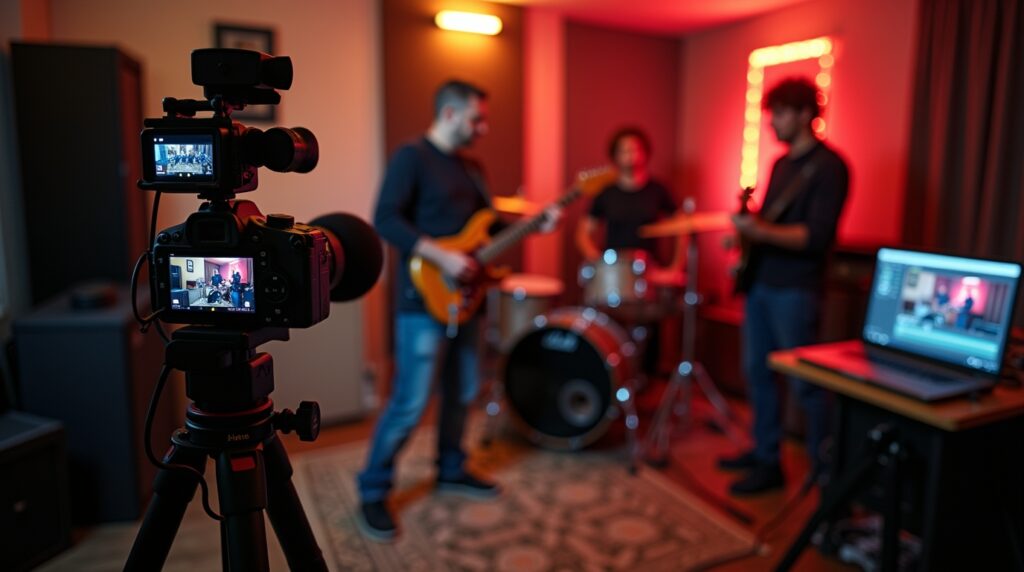Want to give your audience a concert-like experience from home? Learning how to set up a multi-cam live music stream helps you deliver more dynamic, professional broadcasts that keep viewers engaged. In this guide, you’ll learn how to build a multi-camera setup, what gear and software you need, and how to switch angles live—step by step.
What Is a Multi-Cam Live Music Stream?
A multi-cam live music stream uses two or more cameras to capture different angles of a performance—like wide shots, close-ups of instruments, and singer perspectives. These views are edited live using software like OBS, creating a visually interesting stream similar to what you’d see in a concert video.
Why Use Multiple Cameras for Live Music?
- 🎥 More professional-looking streams
- 🎸 Highlight solos, instruments, or audience interaction
- 🔁 Keep your stream visually dynamic
- 🎤 Stand out from basic single-cam performers
- 🚀 Impress followers and encourage engagement/tips
Even with just 2–3 cameras, you can create a massive improvement in the quality of your live show.
What You Need for a Multi-Cam Music Stream
🎧 Audio Setup (Same as single-cam stream)
- Multi-input audio interface or mixer
- Vocal and instrument mics
- Studio headphones or in-ear monitors
📷 Video Gear
- 2 to 4 cameras (DSLRs, webcams, phones, or camcorders)
- Camera tripods or mounts
- HDMI capture cards (e.g. Elgato Cam Link) — one per camera if not using webcams
- USB hub or powered USB extender (for multiple USB cameras)
- Optional: PTZ cameras (remotely controlled pan/tilt/zoom cams)
💻 Streaming Software
- OBS Studio (free) or vMix, Ecamm Live, Streamlabs
- Scene setup with transitions for switching views
- Stream key from your chosen platform (Twitch, YouTube, etc.)
How to Set Up a Multi-Cam Stream (Step-by-Step)
1. Plan Your Angles
Decide on 2–4 angles that complement your performance:
- Wide shot of the full band or room
- Close-up of lead singer
- Instrument focus (guitar, drums, keyboard)
- Overhead shot of mixing console or gear
2. Connect All Cameras
- For webcams: plug each into a separate USB port or USB hub
- For DSLRs/mirrorless: use HDMI capture cards for each input
- Use software like OBS to detect each as a separate video source
3. Set Up OBS Studio
- Create a scene for each camera angle
- Add your audio input from your interface or mixer
- Use hotkeys or a stream deck to switch between scenes easily
- Add transitions for smoother camera changes
You can check our step by step here
4. Sync Audio and Video
- Check for latency between video and audio
- In OBS, use the Sync Offset option to fix delays
- Test thoroughly before going live
5. Test Your Stream
- Do a private stream or record locally
- Check sound levels, lighting, and angle clarity
- Make final adjustments to your camera positions
6. Go Live!
- Add a countdown or “Starting Soon” scene
- Switch views during key moments (e.g. solos, crowd engagement)
- Engage with your chat or add overlays for tips and socials
Top Software for Multi-Cam Streaming
| Software | Platform | Free? | Notable Feature |
|---|---|---|---|
| OBS Studio | Windows/Mac/Linux | ✅ | Free, flexible, plugins support |
| vMix | Windows | ❌ | Pro-grade multi-cam control |
| Ecamm Live | Mac | ❌ | Mac-native, multi-cam made easy |
| Streamlabs | Windows/Mac | ✅ | Built-in overlays & themes |
FAQ
Q: Can I use smartphones as extra cameras?
A: Yes! Apps like EpocCam, DroidCam, or NDI HX Camera let you use phones as wireless webcams.
Q: Will my computer handle multiple cameras?
A: You’ll need a decent CPU (i5/i7 or M1/M2) and a strong GPU to avoid lag. Close other apps and use a wired internet connection.
Q: Do I need a capture card for every camera?
A: Only for cameras that don’t connect via USB (e.g. DSLRs). Webcams and phones don’t need one.
Q: What if my audio and video don’t sync?
A: Use OBS’s sync offset setting or try audio delay plugins to fix mismatches.
Final Thoughts
Now that you know how to set up a multi-cam live music stream, you can take your performances to the next level. Start simple—just two angles can dramatically boost viewer engagement. As you grow, add cameras, lighting, and scene transitions for an even more immersive fan experience.
